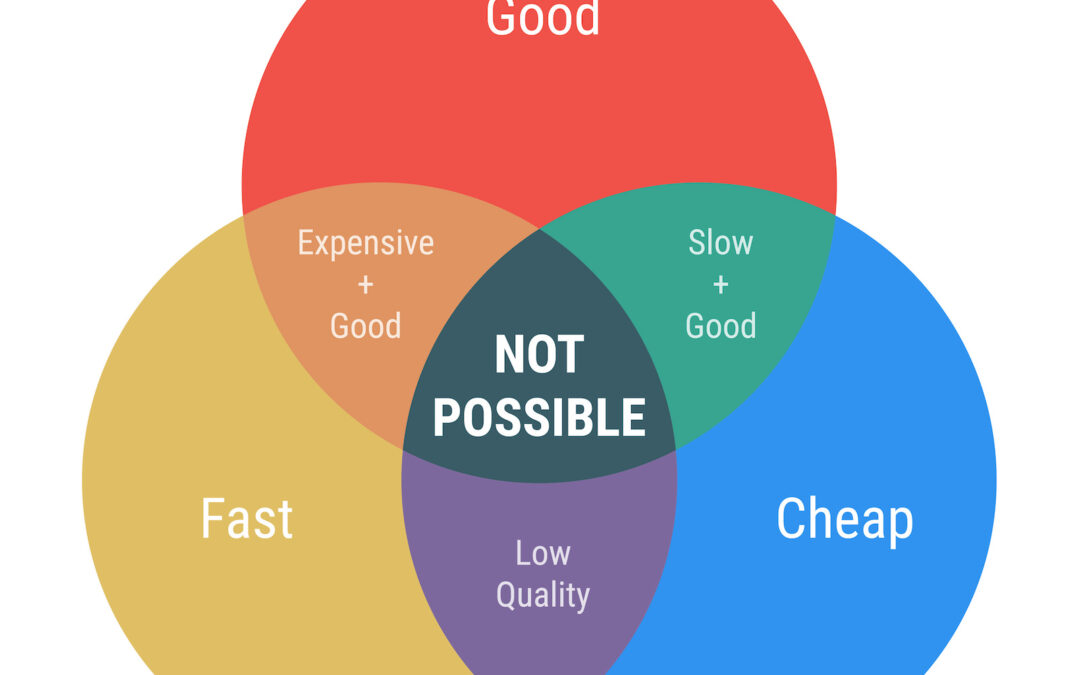Everyone has heard the maxim: “You can have it good, you can have it fast, or you can have it cheap. Pick any two.“
If you want to have a successful business, there are a couple of non-negotiable items here. At an absolute minimum, you must produce a good product or service in order to survive, but to thrive, you must deliver excellence in a consistently repeatable way, and you must be able maintain that excellence as you scale your business.
Just as important, you need to be able to deliver excellent results quickly and efficiently, not only as your business evolves, but as your target market and the business environment at large evolves. Swim in your own lane, of course, but keep an eye on your competitor in the lane next to you!
Which leaves us with cheap, and a couple more maxims:
- You get what you pay for.
- Play now and pay later, or pay now and play later.
It’s tough when you’re first starting your business. Every decision carries the weight of the world, because you have limited time and funds and you don’t want to fail (who does!). You may choose to DIY or hire cheap help in order to get a jump start. While that may seem like a perfectly viable option at the beginning, if you haven’t thought it through, it can hinder your growth and generate a lot of pain down the road when you are forced to toss everything out the window and start over again, either because you can’t scale without losing excellence, or you’ve hit a ceiling in your revenue generation because you can’t work any faster or more efficiently with the current processes you have in place.
Try to start with the end goal in mind — especially when you are a startup. Even if you don’t have a full business plan in place, you should have a good idea of the following:
What are my main revenue generators? Regardless of whether they are products or services, you should have a good grasp of what each of those offerings are, and how much revenue you expect each one to generate for you annually. You could use exact numbers for this, but percentage of total revenue might be easier to visualize.
For our example, we have three offerings:
- Offering A generates 15% of total revenue
- Offering B generates 30% of total revenue
- Offering C generates 55% of total revenue
Take a look at how much each it costs to produce and deliver each offering, from start to finish. This includes the amount of time spent in production and delivery, translated into currency based on the salary of those doing the work (because time is money, right?) Again, this can be done in percentages:
- Offering A costs 40% of total expenses to produce and deliver
- Offering B costs 10% of total expenses to produce and deliver
- Offering C costs 50% of total expenses to produce and deliver
If you anticipate Offering A to generate 15% of your total revenue but it sucks up 40% of your time and effort, it’s time to reexamine the offering. Can you reduce the time expense by implementing an app or hiring a human (at a lower cost) to free up your time? Can you streamline or eliminate any other expenses that will still allow you to deliver Offering A at the same level of quality and speed?
Keep an eye out for the sleeper. Even though Offering C generates 55% of your total revenue, it also costs 50% of your total expenses. Offering B generates 30% of your revenue but only costs 10% of your expenses. Perhaps it’s time to look at how you can funnel more time and effort into increasing your percentage of revenue earned for Offering B!
As mentioned earlier, inefficiencies in business processes are a huge reason for revenue leakage. Business owners choose to DIY their technology solutions, or cobble together a few inexpensive platforms to try to solve their business problems and provide a decent customer experience. Too often, these fragmented processes cause more headache and expense over the long term. Systems don’t talk to one another, forcing you to enter things into multiple systems multiple times, increasing the chance for error and doubling the time spent on a task. Then, when you’ve outgrown the multiple limited solutions, you often can’t easily export your data out to a new, more comprehensive solution. You are forced to start again from scratch, a painful process when you’re running a thriving business that can’t afford to miss a step while you make the transfer.
There are absolutely limits to what you can and should spend on technology to ensure success, and it is essential to right-size your solution in relation to your revenue. But having a few thoughtful conversations with a business coach, mentor, or technology consultant can help you choose a solution that’s right for you and to develop a strategy that ensures your ability to deliver consistent excellence and to scale successfully.

